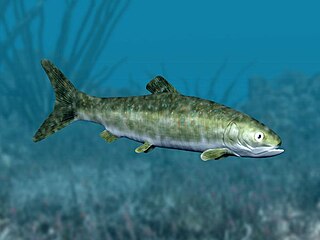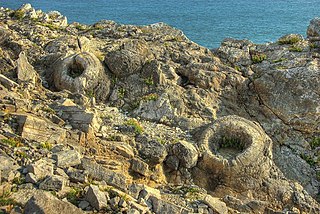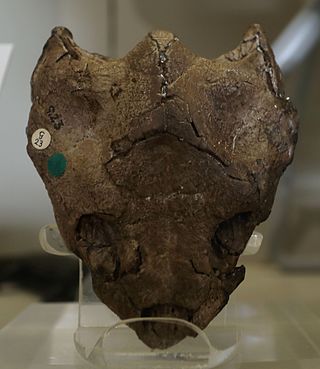Gerhardodon is an extinct genus of mammal from the Lower Cretaceous of southern England. It was a member of the also extinct order of Multituberculata, and lived with such dinosaurs as Iguanodon. It lies within the suborder "Plagiaulacida" and family Pinheirodontidae.
Albionbaatar is an extinct mammal from the Lower Cretaceous Lulworth Formation of England. It was a member of the also extinct order Multituberculata and shared the world with the much larger dinosaurs. It is in the suborder "Plagiaulacida", family Albionbaataridae. The genus Albionbaatar was named by Kielan-Jaworowska Z. and Ensom P.C. in 1994 based on a single species.

Echinodon is a genus of heterodontosaurid dinosaur that lived during the earliest Cretaceous of southern England and possibly western France in the Berriasian epoch. The first specimens were jaw bones named Echinodon becklesii by Sir Richard Owen in 1861, and since their original description only additional teeth have been discovered. The specific name honours collector Samuel Beckles who discovered the material of Echinodon and many other taxa from across England, while the genus name translates as "prickly tooth" in reference to the dental anatomy of the taxon.

The Purbeck Group is an Upper Jurassic to Lower Cretaceous lithostratigraphic group in south-east England. The name is derived from the district known as the Isle of Purbeck in Dorset where the strata are exposed in the cliffs west of Swanage.

Nuthetes is the name given to a genus of theropod dinosaur, likely a dromaeosaurid, known only from fossil teeth and jaw fragments found in rocks of the middle Berriasian age in the Cherty Freshwater Member of the Lulworth Formation in England and also the Angeac-Charente bonebed in France. If it was a dromaeosaurid, Nuthetes would have been a small predator.

Gnathosaurus is a genus of ctenochasmatid pterosaur containing two species: G. subulatus, named in 1833 from the Solnhofen Limestone of Germany, and G. macrurus, known from the Purbeck Limestone of the UK. Its fossil remains dated back to the Late Jurassic period.
Apricosiren is an extinct genus of prehistoric salamander. It is known from the Berriasian aged Lulworth Formation in southern England.

Ichthyokentema ("fish-goad") is an extinct genus of stem-teleost fish that lived during the Late Jurassic. It contains one species, I. purbeckensis, which is known from the Purbeck Group of Dorset, England. I. purbeckensis was originally described as a species of Pholidophorus by William Davies in 1887, but was moved to its own genus by Arthur Smith Woodward in 1941.

The Fossil Forest is the remains of an ancient submerged forest from Jurassic times, located to the east of Lulworth Cove on the Isle of Purbeck in Dorset, England. It lies on the Jurassic Coast, on a wide ledge in the seaside cliff. The site is within the Lulworth Ranges and thus has restricted access. Parts of forest can also be seen on the Isle of Portland and in quarries near the town of Weymouth to the west.

Dorsetochelys is an extinct genus of turtle from the Early Cretaceous of southern England and northwestern Germany.

Oweniasuchus is an extinct genus of goniopholidid mesoeucrocodylian. Remains have been found from England and Portugal that are Cretaceous in age.

Pleurosternon is an extinct genus of freshwater pleurosternid turtle from the latest Jurassic to earliest Cretaceous of Europe. Its type species, P. bullockii was described by the paleontologist Richard Owen in 1853. Since then, and throughout the late 19th century, many fossil turtles were incorrectly assigned to this genus, though only two are currently considered valid.
Dorsetodon is an extinct genus of mammal from the Early Cretaceous (Berriasian) Purbeck Group of Britain. It is represented by isolated lower molars.
Purbeckodon is an extinct genus of mammaliaforms, possibly belonging to Morganucodonta, that is known from Early Cretaceous deposits of southeastern Dorset, England. It was collected in the Purbeck Limestone Group of Dorset. It was first named by Percy M. Butler, Denise Sigogneau-Russell and P. C. Ensom in 2011 and the type species is Purbeckodon batei.

The Lulworth Formation is a geologic formation in England. It dates from the late Tithonian to the mid Berriasian. It is a subunit of the Purbeck Group. In Dorset, it consists of three members, which are in ascending order, the Mupe Member, the Ridgway Member, and the Warbarrow Tout Member. The Mupe Member is typically 11 to 16 m thick and largely consists of marls and micrites with interbeds of calcareous mudstone. The Ridgeway Member is about 3 to 7 m thick and consists of in its western portion carbonaceous muds, marls and micrites, in the east the muds are replaced by micritic limestone. The Warbarrow Tout Member is 17 to 39 m thick and consists of limestone at the base and micrite and mudstone for the rest of the sequence, this member is the primary source of the vertebrate fossils within the formation. Elsewhere the unit is undifferentiated.

Batrachosauroididae is an extinct family of prehistoric salamanders with holarctic distribution. They were paedomorphic and presumably aquatic. They are possibly the sister taxon of Proteidae, an extant family of aquatic salamanders. They are definitively known from the Late Cretaceous to Miocene of North America and Europe. Remains from the earliest Cretaceous (Berriasian) Lulworth Formation of England have tenatively been attributed to this family.
Hylaeochelys is an extinct genus of plesiochelyid turtle that lived during the Late Jurassic-Early Cretaceous in Portugal, Spain, France, and southern England. The type species was originally named by Richard Owen as Pleurosternon latiscutatum in 1853, before being moved to the new genus Hylaeochelys by Richard Lydekker in 1889. Other species included in the genus are H. belli, H. kappa and H. lata, originally named under different genera by Gideon Mantell and Owen, respectively. All species are represented by carapaces, primarily from the Lulworth Formation of the Purbeck Limestone Group that was deposited during the Berriasian.
Purbicella is a genus of extinct squamate from the Early Cretaceous of southern England. The type and only species is Purbicella ragei, which was described by Susan E. Evans, Marc E. H. Jones, and Ryoko Matsumoto in 2012 for a mostly complete and articulated skull from the Berriasian Lulworth Formation of Dorset. The generic name described the region of Purbeck where the fossil was found, while the species name honours paleoherpetologist Jean-Claude Rage. Purbicella has the most complete skull of any British fossil lizard, British Geological Survey (BGS) specimen GSb581, which was originally collected prior to 1911, but then remained in BGS storage until it was rediscovered and described by Evans and colleagues. The skull is unique among coexisting taxa for having fused frontal bones, and Purbicella is likely closer to modern lacertoids than any of the other British forms.
Parasaurillus is a genus of extinct lizard from the Early Cretaceous of southern England. The type and only species is Parasaurillus pseudobtusus, named in 2002 by Susan E. Evans and Belinda Searle for extensive jaw and tooth material that has previously been classified as either Saurillus obtusus or Pseudosaurillus from the Berriasian Lulworth Formation. The taxon was found in the Mammal Bed near the base of the formation alongside the other lizards Becklesius, Dorsetisaurus, Durotrigia, Paramacellodus, Pseudosaurillus, Parviraptor and Saurillus obtusus. It is likely closely related to Scincoidea, more so than other contemporary taxa.
Pseudosaurillus is a genus of extinct lizard from the Early Cretaceous of southern England. The type and only species is Pseudosaurillus becklesi, named in 1967 by R. Hoffstetter limited jaw and tooth material from the Berriasian Lulworth Formation. A large amount of material that was additionally referred to Saurillus by Hoffstetter was reassigned to Pseudosaurillus in 1983 by Estes, but this has since been reclassified within its own genus Parasaurillus by Susan E. Evans and Belinda Searle in 2002. The taxon was found in the Mammal Bed near the base of the formation alongside the other lizards Becklesius, Dorsetisaurus, Durotrigia, Paramacellodus, Parasaurillus, Parviraptor and Saurillus. Like Becklesius, Pseudosaurillus may be a member of the family Paramacellodidae.










